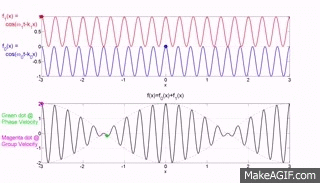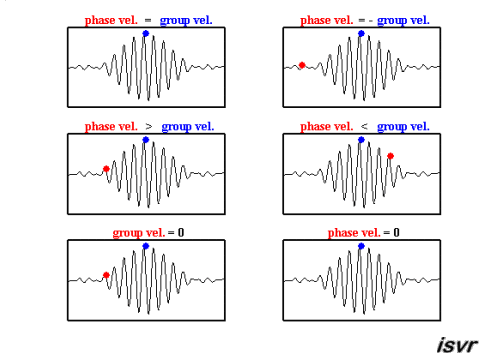Consider some basic cosine waves of the form ${E_i} = {E_0}\cos ({\omega _i}t – {k_i}z)$ with different amplitudes, frequencies and phases. We know a combination of such waves could result in a wave which has an envelope that is traveling at a group velocity and also has a phase velocity.
When there are some basic waves with equal amplitudes propagating in the same direction of propagation, deriving the expression for the resultant wave is easily possible using some simple trigonometric identities.
say when there are two waves of the form: ${E_1} = {E_0}\cos ({\omega _1}t – {k_1}z)$ and ${E_2} = {E_0}\cos ({\omega _2}t – {k_2}z)$ we'll have:
$$\begin{align}
{E_1} + {E_2} &= {E_0}\bigl(\cos ({\omega _1}t – {k_1}z) + \cos ({\omega _2}t – {k_2}z)\bigr) \\
&= 2{E_0}\cos\biggl(\frac{\omega_1 – \omega_2}{2}t – \frac{k_1 – k_2}{2}z\biggr)\cos\biggl(\frac{\omega_1 + \omega_2}{2}t – \frac{k_1 + k_2}{2}z\biggr) \\
&= \biggl\{ 2{E_0}\cos\biggl(\frac{\omega_1 – \omega_2}{2}t – \frac{k_1 – k_2}{2}z\biggr)\biggr\} \cos(\frac{\omega_1 + \omega_2}{2}t – \frac{k_1 + k_2}{2}z\biggr)
\end{align}$$
First part refers to envelope of the resultant wave and group velocity will be derived from this part and the other part deals with the phase velocity.
Deriving such a expression gives a better physical viewpoint of what we are dealing with than when we represent it in the form of a summation of some basic cosine waves. Plus such a relation for the wave function could make it so easy to find out many charactristics of the wave in a brief look at the expression.
Therefore it's so important and helpful to derive an expression for the wave which is caused by superposition of some basic propagating waves. But it was a simple situation.My question is that what if basic waves amplitudes were not the same?
When we are aware of propagation of some basic waves with unequal amplitudes and frequencies, how can we derive the relation for the resultant wave (which actually represent the only changing field in the medium)? And of course I have the same question about the expression for the group velocity.
Like what we did in relation to equal amplitude waves example, is it possible to derive the expressions only by use of simple trigonometric identities?


Best Answer
I'm pretty sure that we can't do any better with trig identities; it looks like any such expression would have a term vaguely like $\sqrt{1 + r \cos \theta}$, and then the square root ruins the nice intuition.
In lieu of that I'll offer a derivation of the group velocity that uses no fancy math at all! Hopefully that's what you wanted, even if you didn't directly ask it.
First off, let's figure out what group velocity is. Apparently, group velocity is the velocity of the envelope of a wave. But what is the envelope of a wave? I can create a wave with any initial position and velocity, so it can be an arbitrarily weird shape. There might be no discernible envelope at all.
So let's back up and find some examples. When we talk about the envelope of a wave, we mean some curve you draw around an oscillation, like this.
In order to do this, there must be a well defined oscillation to draw the envelope around. That means that our wave must be made up of individual frequencies that are close to one central frequency. To make things convenient, let's write that schematically as $$\text{wave} = \sum_{k'} \sin(k'x - \omega(k') t) \text{ for a bunch of } k' \approx k$$ However, if we just have one frequency, the wave is just an infinite sinusoid $\sin(kx)$. This doesn't have an envelope, strictly speaking, because it just goes on forever at the same amplitude. We must have waves of other frequencies, which will constructively and destructively interfere with each other, to actually get an envelope.
So we've concluded that the envelope is defined by where a bunch of sinusoids making up our wave constructively or destructively interfere. Their phases are, as a function of space and time, $$\phi(k') = k'x - \omega(k') t$$ Now let's assume for simplicity that the top of the envelope is at $x = 0$ at time $t = 0$. That means that the waves must constructively interfere there, so all the $\phi(k')$ are about the same.
As time goes on, the envelope will move, but the peak will still be where the phases of the component waves are the same. That means $$\text{peak of envelope satisfies } \frac{d\phi(k')}{dk'} = 0$$ Performing the differentiation, we have $$x - \frac{d\omega(k')}{dk'} t = 0$$ Since we said $k' \approx k$, let's drop the primes and rearrange for $$\frac{x}{t} = \frac{d \omega(k)}{dk}$$ But $x/t$ is exactly the speed of the peak of the envelope, so this is the group velocity.